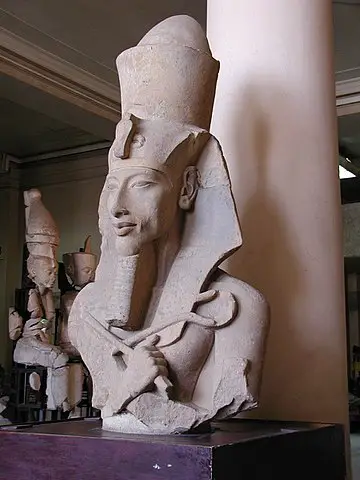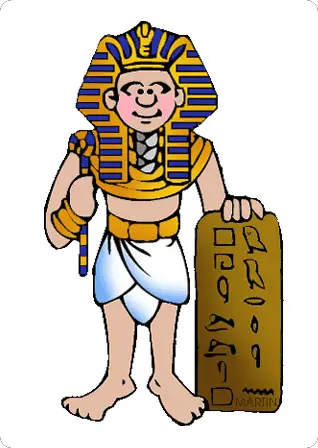Akhenaten
Akhenaten, born around 1380 BC, was an Egyptian pharaoh who ruled during the Eighteen Dynasty of Ancient Egypt. Akhenaten was the second son to the Pharaoh Amenhotep III, but became first in the line of succession following his older brother’s death.
He grew up in the royal palace and learned the art of ruling from his father until his death in the year 1353 BC.

During Akhenaten’s reign, Egypt was at its peak – it was wealthy, powerful, and respected the world over for its contributions to science and architecture. When he took the throne, the country continued to experience great prosperity; but this isn’t what he’s most famous for. Akhenaten’s reign is most famous for the changes it made to the Ancient Egyptian religion; namely, his effort to switch the people from polytheistic worship (the worship of many gods) to the worship of a single god, Aten.
How did Akhenaten try to change the Egyptian faith?
The first way Akhenaten showed his new faith was by changing his name. When he first took the throne, he was named Amenhotep like his father, but changed it to Akhenaten during his fifth year as pharaoh. This changing of his name represented his commitment to the new religion, and means “Living Spirit of Aten” when translated to English.
For thousands of years, the Egyptians worshipped a respected collective of gods: for example, Bast, Isis, Osiris, Horus, Thoth, and Anubis. To weaken the peoples’ faith, Akhenaten built a great number of temples to Aten and closed many of the old ones, going as far as to remove the old gods’ names from their inscriptions. Although many of the Egyptian people didn’t like this, it didn’t trigger revolt in the country – even when Akhenaten changed the location of the capital.
What was the city of Amarna?
Around 1346 BC, Akhenaten ordered that a new city be built to honor Aten. At the time, the city was simply named Akhenaten; but nowadays, archaeologists call it Amarna. Amarna became the capital of Egypt during Akhenaten’s reign. He had a new royal palace built there, as well as the Great Temple of Aten. Following his death, it lost much of its significance; the capital city moved back to Thebes, and the royal palace and temple built there were abandoned entirely.
What else was Akhenaten known for?
Aside from his changes to the Egyptian religion, Akhenaten also ordered a transformation in Egyptian art. Before his reign, Egyptian art was characterized by its lack of realism; people were often drawn with their heads facing the wrong way, for example, in case they came alive and attacked their creators. Any “realistic” art was drawn to the image of the ideal, where everybody had perfect faces and bodies. During Akhenaten’s rule, Egyptian artists began to depict people as they really were, a style which persisted after his death even when policies did not.
Akhenaten’s fame was also boosted by that of his wife, Queen Nefertiti. Nefertiti ruled alongside Akhenaten as the second-in-command of Egypt and was renowned for her wisdom and good looks. She’s often referred to in history as “the most beautiful woman in the world,” and one of the oldest surviving Egyptian sculptures is a carving of her likeness.
Following his death, Akhenaten’s reputation suffered immensely. Because he “defied the traditional ways” by worshipping a different god to the classical Egyptian deities, he was known as “the enemy” in the official records of the pharaohs that succeeded him. The enmity held towards him might be why his body was never discovered – some historians believe that it was destroyed shortly after its burial.
Facts about Akhenaten:
- Akhenaten, born around 1380 BC, was an Egyptian pharaoh who ruled during the Eighteen Dynasty of Ancient Egypt.
- Akhenaten was the second son to the Pharaoh Amenhotep III.
- He grew up in the royal palace, and learned the art of ruling from his father until his death in the year 1353 BC.
- Akhenaten’s reign is most famous for the changes it made to the Ancient Egyptian religion; namely, he tried to change the religion from polytheistic worship (the worship of many gods) to the worship of a single god, Aten.
- When he first took the throne, he was named Amenhotep like his father, but changed it to Akhenaten during his fifth year as pharaoh. This changing of his name represented his commitment to the new religion, and means “Living Spirit of Aten” when translated to English.
- To weaken the peoples’ faith, Akhenaten built new temples to Aten and closed many of the old ones, going as far as to remove the old gods’ names from their inscriptions
- Around 1346 BC, Akhenaten ordered that a new city be built to honor Aten. At the time, it was simply named Akhenaten; but nowadays, archaeologists call it Amarna.
- Amarna became the capital of Egypt during Akhenaten’s reign. He had a new royal palace built there, as well as the Great Temple of Aten.
- Akhenaten also ordered a transformation in Egyptian art, which saw a shift towards realism rather than abstract expression.
- Akhenaten’s fame was also boosted by that of his wife, Queen Nefertiti, who is often referred to as “the most beautiful woman in history.”
- Following his death, Akhenaten’s reputation suffered immensely. He was known as “the enemy” in the official records of the pharaohs that succeeded him, and it’s believed that his body might have been destroyed after its burial.
QUESTIONS:
- When was Akhenaten born?
- 1380 BC.
- What was Akhenaten’s name before his fifth year as pharaoh?
- Amenhotep (like his father!)
- What was the name of the god Akhenaten worshipped?
- What was Queen Nefertiti often described as in historical documents?
- The most beautiful woman in the world.
- Why was Akhenaten despised after his death?
- He defied the tradition of Egyptian worship.



